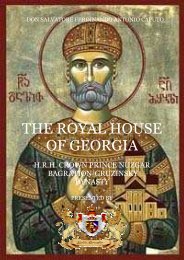here - Nobility Associations
here - Nobility Associations
here - Nobility Associations
You also want an ePaper? Increase the reach of your titles
YUMPU automatically turns print PDFs into web optimized ePapers that Google loves.
Prior to 1268, the principal Pretender to the throne of Jerusalem was Conradin, a<br />
great-grandson of Isabella I of Jerusalem. He was executed in 1268 by Charles of<br />
Anjou, who had by papal authority seized Conradin's rightful Kingdom of Sicily. At<br />
the time of his death, Mary was the only living grandchild of Queen Isabella; this<br />
allowed her to claim the throne of Jerusalem on the basis of proximity in blood to<br />
the Kings of Jerusalem [ (in feudal successions, proximity - a form of seniority - was<br />
a strong claim). The Haute Cour of Jerusalem passed over her claim, however, and<br />
instead chose Hugh III of Cyprus - a great grandson of Queen Isabella - as the next<br />
ruler of the Kingdom of Jerusalem.<br />
Maria then went to Rome and proposed the sale of her rights to Charles of Anjou;<br />
with papal blessing and confirmation, these were sold to Charles in 1277. Charles<br />
then took the title King of Jerusalem, and conquered Acre, holding it until 1285.<br />
T<strong>here</strong>after, the claim to the Kingdom of Jerusalem frequently changed hands,<br />
being passed down by testament or conquest rather than by direct inheritance.<br />
Maria died in Castello de Canosa, Apulia, after 10 December 1307.<br />
The title of King of Jerusalem continued to be borne in a spirit of rivalry: by<br />
the Kings of Cyprus belonging to the House of Lusignan; and by the two Houses<br />
of Anjou which claimed to hold their rights from Mary of Antioch. In 1459<br />
Charlotte, daughter of John III, King of Cyprus, married Louis of Savoy, Count<br />
of Geneva, and in 1485 ceded her rights to Jerusalem to her nephew<br />
Charles of Savoy; hence, from that time up to 1870, the title of King<br />
of Jerusalem was borne by the princes of the House of Savoy.<br />
The House of Antioch has origins German-Italian-French. But on the birth of<br />
Frederick little is known, thinking that he was the illegitimate son of Frederick II.<br />
The names of Antioch, for many historians, exclude the line paternal genealogical<br />
stating that it could be tied to the maternal legate. The simplest explanation of the<br />
name "Antioch" would be that the mother was descended from the Norman<br />
Bohemond of Hauteville, son of Robert Guisgardo. As we know, Bohemond<br />
conquered Antioch in the First Crusade on 3 June 1098, of which he was named<br />
prince.<br />
Bartolomeo da Neocastro (Historia Sicula, cit., P. 21) and also Pirro (See R. Pirro,<br />
Sicily, op. Cit. 25-35) states that the mother of Frederick is legitimate wife of<br />
the Emperor. According to these testimonies Frederick of Antioch should be<br />
considered legitimate son of the Emperor and the fourth wife: “Quarta vero uxor<br />
fuit inclyta Beatrix filia principis Antiochiae, ex quibus susceptus fuit Fridericus<br />
de Antiochia tantum, quem peter Caesar in regem Tusciae constituit, et<br />
Principatum Antiochiae non negavit, sed, proper mortem patris supervenientem,<br />
in regem non potuit filius publicari”.<br />
The Hohenstaufen Dynasty - Page 126 of 200



